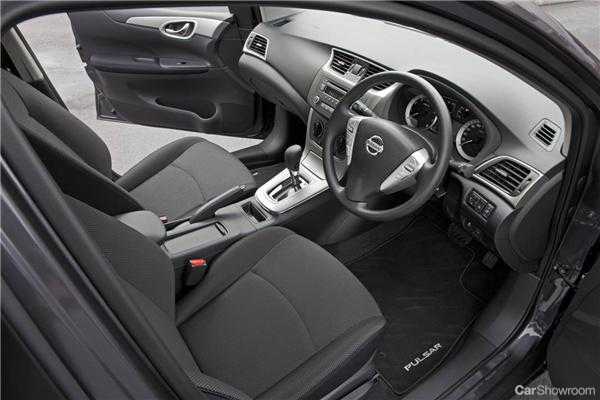Four months after launch of the sedan version, Nissan has completed the Pulsar name’s renaissance with the introduction of the four-model hatchback lineup. As it was last time around, the Pulsar hatchback range is headed by a sporty SSS model – this time powered by a new, turbocharged 1.6-litre, four-cylinder petrol engine.
Nissan sold 83,619 vehicles in Australia during the Japanese financial year which ended on 31 March – an all-time record. There is an update due for the Murano mid-size SUV and before year’s end we’ll see the funky Juke crossover, the all-new Pathfinder SUV and all-new Altima sedan (the spearhead of the company’s V8 Supercar racing program which will replace the Maxima).
But ask any Nissan dealer which are the most important nameplates for their business and they’ll tell you: ‘Pulsar’ and ‘Navara’. Now the Pulsar is back better and bigger (and we do mean bigger) than ever before).
Nissan Pulsar Hatchback Overview
The all-new Nissan Pulsar hatchback was designed at Nissan’s design studios in Japan and rides on the same platform as the sedan versions (the North American Sentra). Pulsars for Australia are sourced from Nissan’s Thailand manufacturing facility.
Nissan has launched the all-new Pulsar hatchback in four model grades – entry-level ST and mid-grade ST-L (both powered by the sedan version’s naturally-aspirated 1.8-litre, four-cylinder petrol engine), and the sporty ST-L and SSS (both of which enjoy the new turbocharged 1.6-litre, four-cylinder petrol engine).
As we saw with the Pulsar sedan, Nissan’s product planners have done a great job in the standard equipment department with the entry-level ST model hatchback boasting cruise control, central locking with remote keyless entry, air-conditioning and 16-inch alloy wheels.
Next-up the Nissan Pulsar ST-L adds front fog lights, rear spoiler, an extra two speakers for the audio system (now six speakers), leather-accented steering wheel, upscale seat cloth and a 4.3-inch colour screen.
Nissan Pulsar ST-S ramps-up the technology with the turbocharged 1.6-litre engine, 17-inch alloy wheels and M-mode manual function for the CVT automatic transmission.
The return of the iconic, sporty Nissan Pulsar SSS brings (as well as the turbocharged powerplant) Xenon headlights, sports body kit (front spoiler, side skirts, rear lower spoiler), integrated 5.8-inch colour touch-screen for the satellite navigation and reversing camera images, leather-accented seats and push-button start.
Here’s how the full lineup looks:
ST (manual) $18,990
ST (automatic) $21,240
ST-L (manual) $22,490
ST-L (automatic) $24,740
ST-S (manual) $24,990
ST-S (automatic) $27,490
SSS (manual) $29,240
SSS (automatic) $31,740
Nissan Pulsar Hatchback Engine
Nissan Pulsar hatchback ST and ST-L models employ the same naturally-aspirated 1.8-litre, four-cylinder petrol engine as the sedan. Maximum power is 96kW at 6000rpm, peak torque of 174Nm is delivered at 4800rpm and combined cycle fuel consumption is rated at 7.2l/100kms (manual) or 6.7l/100kms (automatic).
Of course the good news is the new turbocharged 1.6-litre, four-cylinder petrol engine code-named MR16DDT. On the all-new Pulsar hatchback, this engine is badged ‘DIG Turbo’ (Direct Injection Gasoline) and we’ll see this engine in a range of future Nissans including the Juke crossover later this year.
It’s a lightweight 16-valve engine with an intercooled single scroll turbocharger and twin variable valve control. Maximum power is 140kW at 5600rpm, peak torque of 240Nm arrives at 2000rpm and combined cycle fuel consumption is rated at 7.7l/100kms (six-speed manual) or 7.8l/100kms (automatic).
All drive the front wheels via a six-speed manual transmission or Nissan’s Xtronic Continuously Variable Transmission (CVT) with sports manual mode on ST-S and SSS models.
Nissan Pulsar Hatchback The Interior
As per the Nissan Pulsar sedan, ‘space’ is the defining feature of the hatchback model’s interior – rear seat legroom is more like a medium/large sedan than a small hatchback. A plus – unlike the sedan model – is the 60:40 split-fold rear seat.
Otherwise the various hatchback models mirror equivalent sedans (cloth trim for the ST, premium cloth for the ST-L and ST-S and leather for the SSS).
On the audio front, some will be disappointed the entry-level ST does not have USB or iPod compatibility.
The sporty three-spoke steering wheel adjusts for height and reach and there is height adjustment for the drivers’ seat to ensure a nice driving position (although this is let-down by the lack of a left foot-rest). We reckon the SSS model needs height adjustment for the passenger seat as the version we sampled seemed to have the passenger towering over the driver – strange.
Luggage capacity is on-par with others in this segment.
Nissan Pulsar Hatchback Exterior & Styling
Like its sedan sibling, the Nissan Pulsar hatchback provides a contemporary look which is aerodynamic but a tad conservative. We like the front-end with its large, modern headlights and up-market grille.
Side profile highlights Nissan Pulsar hatchback’s sloping waistline and sophisticated fender curves, while the rear showcases nice-design tail-lights and a good-looking hatch.
Interestingly the sporty SSS is 20mm longer than the rest at 4135mm, and is 10mm narrower in the track (front and rear) at 1530mm.
SSS scores a sports bodykit and ST-L gains a rear spoiler.
Nissan Pulsar hatch ST and ST-L ride on 16-inch alloy wheels, while ST-S and SSS sit on 17-inch alloys.
Nissan Pulsar Hatchback On The Road
We covered some familiar roads during this new model launch – Nissan sent us over many of the same roads we use every week in our high speed mountain roads test loop. So fortunately we were behind the wheel of a manual SSS Pulsar when we tackled the curves around Olinda, East of Melbourne.
That turbocharged 1.6-litre, four-cylinder petrol engine is a pearler. And it loves to rev – delivering a real surge of performance once 4500rpm is on-board.
Equally impressive is the six-speed manual transmission which is nicely mated to the characteristics of the powerplant and is ‘fingertip-smooth’ to shift up and down the ratios.
Nissan actually undertook substantial Australian testing of Pulsar hatchback’s MacPherson strut front/torsion beam rear suspension which resulted in two unique calibrations of spring and damper settings, with the SSS naturally slightly firmer in all departments over the others. So, despite the varying dry/damp/wet/drying road surfaces encountered during the day, our Nissan Pulsar SSS cornered with little body roll and turned-in with commendable crispness (hard-core enthusiasts might like a tad more compression firmness in the front struts).
A special word for the power steering in all models which provides variable assistance with nice lightness at low speeds but great feedback and feel as speeds increase.
Impressive in all models was the refinement. Like the all-new Pulsar sedan, Nissan has done a great job insulating the interior of the hatchback from both mechanical noise and the rumble of outside traffic.
Another plus is the low waistline/large glass house which provides good all-round visibility and combines with the handy 10.7-metre turning circle to make the Nissan Pulsar hatchback a snack to park. Only the range-topping SSS model scores a reversing camera.
Nissan Pulsar Hatchback Challenges
Best-in-class interior space and a rip-snorting turbocharged 1.6-litre are the highlights of the all-new Pulsar hatchback. Interior and exterior styling isn’t (a highlight).
Nissan Pulsar Hatchback Verdict
At CarShowroom we are unabashed hot-hatchback fans. So naturally the various Audi S3 and Mercedes-Benz A-Class variants are favourites and you must always include the likes of Golf GTI and R models…albeit for considerably more coin that Nissan Pulsar SSS or Holden Cruze SRi-V.
We have fond memories of the previous generation Pulsar SSS models we’ve actually owned and there’s no doubt Nissan has pitched the all-new model head-to head with Holden Cruze which, as regular CarShowroom readers will know, we rate very highly.
But the question is: does the all-new Pulsar hatchback match the expectation? Yes, yes it does is the short answer.
In a nutshell, Nissan has specified the ST and ST-L models comprehensively and priced them very sharply, while the turbocharged ST-S and SSS variants are sporty hatchbacks to rival the best (and they’re comprehensively equipped and sharply priced as well). All share the largest interiors in the class - which reinforces their value proposition and appeal to family buyers.
Previous SSS buyers might feel the newcomer isn’t quite as edgy/racy as its predecessors – but we reckon it’s still plenty fast, grippy and sporty to rival the Cruze SRi-V and Mazda3 SP25.
Nissan Pulsar Hatchback The Competition
Nissan Pulsar SSS takes-on Holden Cruze SRi-V ($29,240 for the Pulsar versus $29,490 for the Cruze in manual or $32,433 versus $31,790 for the automatic). Pulsar is ahead for grunt (140kW/240Nm to 103kW/200Nm), refinement, driving dynamics and interior space, but we prefer the Cruze’s six-speed automatic to the Pulsar’s CVT.
It’s the same for the Pulsar ST-S ($24,990 manual or $27,490 auto) which goes head-to-head with Cruze SRi ($25,990 manual or $28,290 automatic).
ST and ST-L models tackle the whole small hatchback fraternity, headed by Toyota Corolla (starting price $19,990) and Mazda3 (from $20,330).
But these days you must factor-in Kia Cerato and Hyundai i30 because both are excellent and save some dollars.
Apart from its sharp prices, where Nissan Pulsar lands a knockout blow in this league is interior space – that massive rear-seat legroom is a major selling point.






























